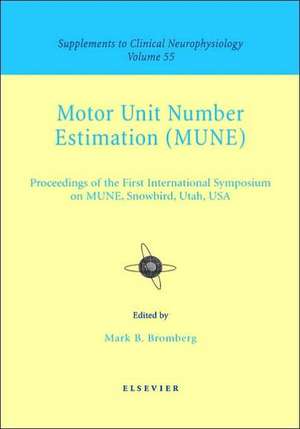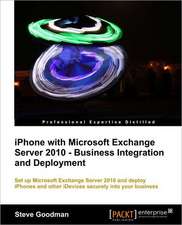Motor Unit Number Estimation: Supplement to Clinical Neurophysiology Series, Volume 55: Supplements to Clinical Neurophysiology, cartea 55
Editat de M. B. Brombergen Limba Engleză Hardback – 12 mai 2003
Relevant lower motor neuron disorders include amyotrophic lateral sclerosis (ALS), spinal muscular atrophy and Charcot-Marie-Tooth inherited neuropathies. To date, there has been no formal meeting of investigators working in the field of MUNE.
The symposium is designed to: (a) review and discuss the methods, advantages and disadvantages of each MUNE technique; (b) review previous applications of MUNE in research and clinical trials; (c) formulate plans for further studies to clarify issues that affect the accuracy and utility of MUNE.
The symposium and workshop included an international roster of approximately 20 invited speakers who presented formal talks on the methods, assumptions, techniques and applications. Presentations by representatives from EMG equipment manufacturers were given. Each talk was followed by a discussion session, and groups of talks by a panel discussion. This publication is meant to serve as a manual for the theory and practice of MUNE. Currently, there is no book addressing MUNE.
Preț: 1552.81 lei
Preț vechi: 1941.02 lei
-20% Nou
Puncte Express: 2329
Preț estimativ în valută:
297.15€ • 307.01$ • 247.18£
297.15€ • 307.01$ • 247.18£
Carte tipărită la comandă
Livrare economică 19 martie-02 aprilie
Preluare comenzi: 021 569.72.76
Specificații
ISBN-13: 9780444507235
ISBN-10: 044450723X
Pagini: 362
Ilustrații: 1
Dimensiuni: 178 x 254 x 21 mm
Greutate: 0.84 kg
Ediția:New.
Editura: Elsevier
Seria Supplements to Clinical Neurophysiology
Locul publicării:Netherlands
ISBN-10: 044450723X
Pagini: 362
Ilustrații: 1
Dimensiuni: 178 x 254 x 21 mm
Greutate: 0.84 kg
Ediția:New.
Editura: Elsevier
Seria Supplements to Clinical Neurophysiology
Locul publicării:Netherlands
Cuprins
Section I. Special Lecture.
1. Review of MUNE over 30 years (R. Sica, A. McComas). Discussion after Section I.
Section II. MUNE Physiology.
2. Axon excitability in motor unit number estimation (T.J. Doherty, D.W. Stashuk, W.F. Brown). 3. Issues in motor unit number estimation (M.P. Slawnych). Discussion after Section II.
Section III. Stimulation MUNE Techniques.
4. Multiple point stimulation and F-response MUNE techniques (T.J. Doherty, D.W. Stashuk, W.F. Brown). 5. Adapted multiple point stimulation MUNE technique (F.C. Wang, O. Bouquiaux et al. ). 6. MUNE by intraneural microstimulation and the effects of averaging of unitary muscle action potentials (K. Arasaki). 7. MUNE by statistical analysis (J.R. Daube). 8. Multiple point stimulation MUNE with integrated single motor unit tracking (C.L. Gooch, P. Kaufmann). 9. Statistical MUNE in larger muscles (C.L. Gooch, W. Trojaborg). 10. Comparison of statistical and multiple point stimulation MUNE techniques (C. Lomen-Hoerth, R.K. Olney). Discussion after Section III.
Section IV. Voluntary MUNE Techniques.
11. Spike triggered averaging MUNE technique (M.B. Bromberg). 12. MUNE using decomposition-enhanced spike triggered averaging (D.W. Stashuk, T.J. Doherty, W.F. Brown). 13. Rectified integrated EMG and MUNE (J.H. Petajan). 14. Motor unit number index (MUNIX): a pilot study (S.D. Nandedkar, D.S. Nandedkar et al. ). Discussion after Section IV.
Section V. MUNE in Normal Subjects.
15. Establishing normal MUNE values (V.H. Lawson). 16. Are motor and sensory responses and MUNE values inherited traits? (C. Lomen-Hoerth, R.K. Olney). 17. MUNE measurement of age-related changes (T.J. Doherty, D.W. Stashuk, W.F. Brown). Discussion after Section V.
Section VI. MUNE in Disease States.
18. MUNE in ALS: natural history and implications (J. Turnbull, J. Martin et al. ). 19. Using MUNE to make linear estimates of rate of progression in ALS (C. Armon). 20. MUNE in spinal muscular atrophy (K.J. Swoboda, M.B. Bromberg). 21. MUNE in prior poliomyelitis and spinal muscular atrophy (D. Fehlings, V. Galea et al. ). 22. A longitudinal analysis of MUNE in subjects with a prior paralytic poliomyelitis (E.J. Sorenson, J.R. Daube, A.J. Windebank). 23. MUNE in Charcot-Marie-Tooth neuropathies (R.A. Lewis, J. Li et al. ). Discussion after Section VI.
Section VII. MUNE Correlations with Other Metrics.
24. Relationships between motor unit activation and muscle force generation (R.A. Conwit, D. Stashuk, E.J. Metter). 25. Longitudinal tracking of contractile properties of human motor units by the multiple point stimulation technique (K.M. Chan, W.F. Brown). 26. Longitudinal tracking of single motor units: techniques and applications (C.L. Gooch). 27. Correlations between MUNE obtained by the intraneural microstimulation technique and the Appel clinical rating scale (K. Arasaki). 28. Relationships between MUNE and muscle strength (A.G. Smith, V. Lawson). Discussion after Section VII.
Section VIII. MUNE in Clinical Practice.
29. MUNE in the electrodiagnostic clinic (A.R.M. Upton, A.J. McComas). 30. MUNE in clinical EMG practice (B.E. Smith).
Section IX. MUNE in Clinical Trials.
31. The use of statistical MUNE in ALS to predict prognosis (R.K. Olney). 32. Multiple point stimulation MUNE with single motor unit tracking in a therapeutic ALS trial (C.L. Gooch, P. Kaufmann, Y. Harati). 33. MUNE in an ALS treatment trial (J.M. Shefner). 34. Increasing muscle sampling to improve MUNE power in the clinical trial setting (E.J. Sorenson, J.R. Daube, A.J. Windebank). Discussion after Section IX.
Section X. MUNE in Animal Studies.
35. MUNE studies in mouse models of motor neuron disease (J.M. Shefner). 36. MUNE by intraneural microstimulation: animal studies (K. Arasaki). Discussion after Section X.
Section XI. MUNE Relationship with Industry and Regulatory Agencies.
37. Software issues in MUNE (M.B. Bromberg). 38. Product program development in industry (J. Leedham). 39. MUNE as an endpoint in clinical trials (W.W. Bryan). Discussion after Section XI.
Section XII. Consensus.
40. Consensus (M.B. Bromberg). 41. Issues for the future (M.B. Bromberg).
Subject Index.
1. Review of MUNE over 30 years (R. Sica, A. McComas). Discussion after Section I.
Section II. MUNE Physiology.
2. Axon excitability in motor unit number estimation (T.J. Doherty, D.W. Stashuk, W.F. Brown). 3. Issues in motor unit number estimation (M.P. Slawnych). Discussion after Section II.
Section III. Stimulation MUNE Techniques.
4. Multiple point stimulation and F-response MUNE techniques (T.J. Doherty, D.W. Stashuk, W.F. Brown). 5. Adapted multiple point stimulation MUNE technique (F.C. Wang, O. Bouquiaux et al. ). 6. MUNE by intraneural microstimulation and the effects of averaging of unitary muscle action potentials (K. Arasaki). 7. MUNE by statistical analysis (J.R. Daube). 8. Multiple point stimulation MUNE with integrated single motor unit tracking (C.L. Gooch, P. Kaufmann). 9. Statistical MUNE in larger muscles (C.L. Gooch, W. Trojaborg). 10. Comparison of statistical and multiple point stimulation MUNE techniques (C. Lomen-Hoerth, R.K. Olney). Discussion after Section III.
Section IV. Voluntary MUNE Techniques.
11. Spike triggered averaging MUNE technique (M.B. Bromberg). 12. MUNE using decomposition-enhanced spike triggered averaging (D.W. Stashuk, T.J. Doherty, W.F. Brown). 13. Rectified integrated EMG and MUNE (J.H. Petajan). 14. Motor unit number index (MUNIX): a pilot study (S.D. Nandedkar, D.S. Nandedkar et al. ). Discussion after Section IV.
Section V. MUNE in Normal Subjects.
15. Establishing normal MUNE values (V.H. Lawson). 16. Are motor and sensory responses and MUNE values inherited traits? (C. Lomen-Hoerth, R.K. Olney). 17. MUNE measurement of age-related changes (T.J. Doherty, D.W. Stashuk, W.F. Brown). Discussion after Section V.
Section VI. MUNE in Disease States.
18. MUNE in ALS: natural history and implications (J. Turnbull, J. Martin et al. ). 19. Using MUNE to make linear estimates of rate of progression in ALS (C. Armon). 20. MUNE in spinal muscular atrophy (K.J. Swoboda, M.B. Bromberg). 21. MUNE in prior poliomyelitis and spinal muscular atrophy (D. Fehlings, V. Galea et al. ). 22. A longitudinal analysis of MUNE in subjects with a prior paralytic poliomyelitis (E.J. Sorenson, J.R. Daube, A.J. Windebank). 23. MUNE in Charcot-Marie-Tooth neuropathies (R.A. Lewis, J. Li et al. ). Discussion after Section VI.
Section VII. MUNE Correlations with Other Metrics.
24. Relationships between motor unit activation and muscle force generation (R.A. Conwit, D. Stashuk, E.J. Metter). 25. Longitudinal tracking of contractile properties of human motor units by the multiple point stimulation technique (K.M. Chan, W.F. Brown). 26. Longitudinal tracking of single motor units: techniques and applications (C.L. Gooch). 27. Correlations between MUNE obtained by the intraneural microstimulation technique and the Appel clinical rating scale (K. Arasaki). 28. Relationships between MUNE and muscle strength (A.G. Smith, V. Lawson). Discussion after Section VII.
Section VIII. MUNE in Clinical Practice.
29. MUNE in the electrodiagnostic clinic (A.R.M. Upton, A.J. McComas). 30. MUNE in clinical EMG practice (B.E. Smith).
Section IX. MUNE in Clinical Trials.
31. The use of statistical MUNE in ALS to predict prognosis (R.K. Olney). 32. Multiple point stimulation MUNE with single motor unit tracking in a therapeutic ALS trial (C.L. Gooch, P. Kaufmann, Y. Harati). 33. MUNE in an ALS treatment trial (J.M. Shefner). 34. Increasing muscle sampling to improve MUNE power in the clinical trial setting (E.J. Sorenson, J.R. Daube, A.J. Windebank). Discussion after Section IX.
Section X. MUNE in Animal Studies.
35. MUNE studies in mouse models of motor neuron disease (J.M. Shefner). 36. MUNE by intraneural microstimulation: animal studies (K. Arasaki). Discussion after Section X.
Section XI. MUNE Relationship with Industry and Regulatory Agencies.
37. Software issues in MUNE (M.B. Bromberg). 38. Product program development in industry (J. Leedham). 39. MUNE as an endpoint in clinical trials (W.W. Bryan). Discussion after Section XI.
Section XII. Consensus.
40. Consensus (M.B. Bromberg). 41. Issues for the future (M.B. Bromberg).
Subject Index.








